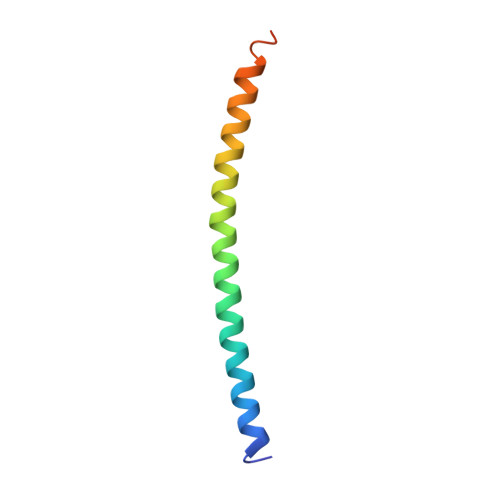Structural and biochemical insights into the role of testis-expressed gene 14 (TEX14) in forming the stable intercellular bridges of germ cells.
Kim, H.J., Yoon, J., Matsuura, A., Na, J.H., Lee, W.K., Kim, H., Choi, J.W., Park, J.E., Park, S.J., Kim, K.T., Chang, R., Lee, B.I., Yu, Y.G., Shin, Y.K., Jeong, C., Rhee, K., Lee, H.H.(2015) Proc Natl Acad Sci U S A 112: 12372-12377
- PubMed: 26392564
- DOI: https://doi.org/10.1073/pnas.1418606112
- Primary Citation of Related Structures:
3WUT, 3WUU, 3WUV - PubMed Abstract:
Intercellular bridges are a conserved feature of spermatogenesis in mammalian germ cells and derive from arresting cell abscission at the final stage of cytokinesis. However, it remains to be fully understood how germ cell abscission is arrested in the presence of general cytokinesis components. The TEX14 (testis-expressed gene 14) protein is recruited to the midbody and plays a key role in the inactivation of germ cell abscission. To gain insights into the structural organization of TEX14 at the midbody, we have determined the crystal structures of the EABR [endosomal sorting complex required for transport (ESCRT) and ALIX-binding region] of CEP55 bound to the TEX14 peptide (or its chimeric peptides) and performed functional characterization of the CEP55-TEX14 interaction by multiexperiment analyses. We show that TEX14 interacts with CEP55-EABR via its AxGPPx3Y (Ala793, Gly795, Pro796, Pro797, and Tyr801) and PP (Pro803 and Pro804) sequences, which together form the AxGPPx3YxPP motif. TEX14 competitively binds to CEP55-EABR to prevent the recruitment of ALIX, which is a component of the ESCRT machinery with the AxGPPx3Y motif. We also demonstrate that a high affinity and a low dissociation rate of TEX14 to CEP55, and an increase in the local concentration of TEX14, cooperatively prevent ALIX from recruiting ESCRT complexes to the midbody. The action mechanism of TEX14 suggests a scheme of how to inactivate the abscission of abnormal cells, including cancer cells.
Organizational Affiliation:
Department of Bio & Nano Chemistry, Kookmin University, Seoul 136-702, Korea;















